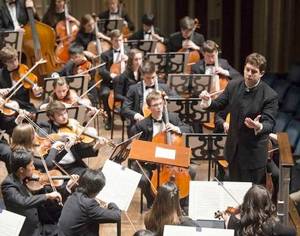by Mike Telin

The program will also feature the Cleveland Orchestra Youth Chorus, who will join the orchestra for performances of music by Aaron Copland and Johannes Brahms. A prelude concert will be presented in Reinberger Chamber Hall beginning at 7:00 pm.
In order to give his players a head start with learning Stravinsky’s seminal work, Mitchell enlisted the assistance of The Cleveland Orchestra itself. “The first rehearsal back in December was a side-by-side with TCO. The opportunity to sit next to professionals, who have played the piece many times, really helped the young musicians up the confidence factor. As a result they came into the second rehearsal far more assured because of that experience.”
Three days prior to our conversation, Mitchell arranged for a second side-by-side rehearsal. “This is the first time we have ever approached a project like this with side-by-sides at the front and the back ends of the rehearsal process. To watch the professionals and the young musicians come together — and watch the one-on-one mentoring relationships that develop — was heartwarming and speaks miles about our organization and how truly interwoven COYO is into the fabric of TCO. We’re all part of the Musical Arts Association, we’re all in this together with the same mission: to present the best music we possibly can for our audiences.”
Mitchell pointed out that learning Pétrouchka is not like learning a work where every bar is in the same meter. In fact, he noted that of Stravinsky’s big three ballet scores, Pétrouchka is the most rhythmically complicated.
“It’s funny because everybody points to The Rite of Spring, but with the exception of the ‘Sacrificial Dance’ — which is a very tricky five minutes of music — rhythmically speaking Pétrouchka is more complicated. It’s not only that the piece changes meter almost every bar. In many places there are multiple groups of instruments playing in different meters from each other — one group in three and another in eight. It’s one of those pieces where the concentration level has to remain super high all of the time. You can never let your guard down.”
The concert’s second half will be dedicated to works for chorus and orchestra. The Cleveland Orchestra Youth Chorus, prepared by their director Lisa Wong, will be featured in Aaron Copland’s Canticle of Freedom and Johannes Brahms’s Schicksalslied (Song of Destiny).
“I love vocal music,” Mitchell exclaimed. “I did a lot of accompanying when I was an undergrad and while I enjoyed working with instrumentalists, what really got my creative juices flowing was working with singers. One of my great loves, aside from music, is words. I love poetry, drama, novels, non-fiction. I’m a big reader.”
Mitchell added that the annual COYO and Youth Chorus concert gives him the opportunity to work with Lisa Wong. “I cannot speak highly enough about Lisa. She’s a phenomenal musician and director, and a great colleague. I just adore her.”
Mitchell described the Brahms Schicksalslied as one of the great works in the orchestral-choral repertoire, but it was not until he and Wong were discussing repertoire that he discovered the Copland. “He wrote it for an amateur chorus, so instead of writing in four-part harmony, most of the piece is in two-part harmony, which makes it a great work for young voices,” Mitchell said. “It’s a beautiful piece and I’m not sure why it doesn’t get performed more often. Perhaps it’s because the chorus doesn’t enter until maybe two thirds of the way through. But it works well if you put the Copland back to back with the Brahms, which has a lovely introduction and postlude and really features the chorus throughout. The two pieces make for a very satisfying second half.”
Published on ClevelandClassical.com March 1, 2016.
Click here for a printable copy of this article

